A comparative test
by TRA
Further tests of 500 & 600mm lenses
Part 2
The Test Results
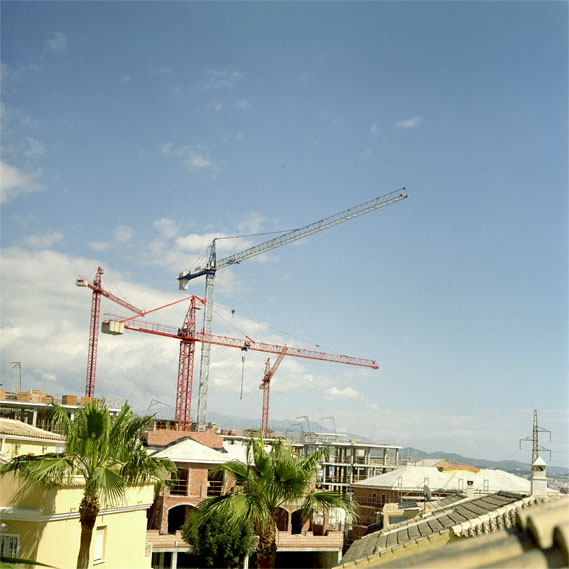
[C427-7]
View chosen for the 500mm – 1000mm tests
1980s Biometar f/2.8 80mm at f/9.5 1/500
Further tests of 500 & 600mm lenses
Part 2
The Test Results

[C427-7]
View chosen for the 500mm – 1000mm tests
1980s Biometar f/2.8 80mm at f/9.5 1/500
Presentation
We will divide the presentation of the test results into three groups of lenses:
This lens is long and heavy, but it is a pleasure to work with it. The viewfinder image is bright and focussing is easy. It is of course a pre-set lens, so operation is a little slower than with automatic lenses.
Coverage
Coverage is very close to being absolutely even across the whole of
the frame at maximum aperture and also at f/11.
500mm Pentacon
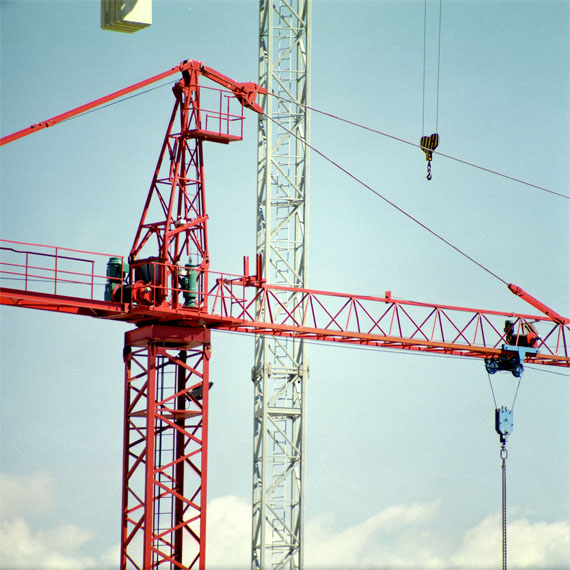
[C426-1_2] 500mm Pentacon at f/5.6 1/500 |
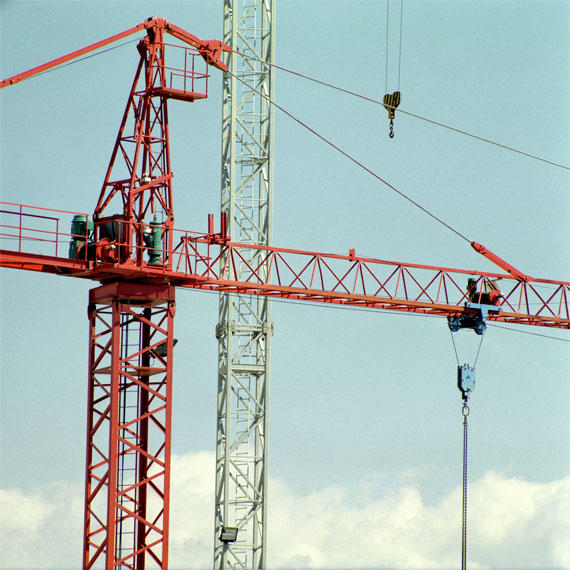
[C426-3] 500mm Pentacon at f/11 1/125 |
Resolution
Resolution with this lens is excellent, even at full aperture.
The point of critical focus in these two images is clearly on the rear
crane.
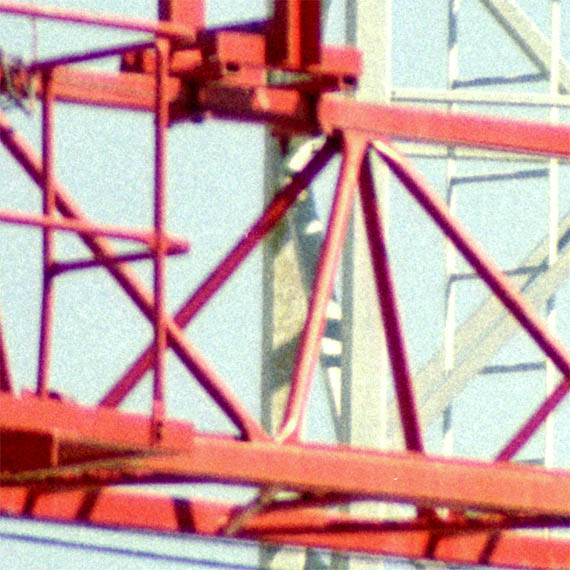
[C426-1_2r] 500mm Pentacon at f/5.6 1/500 |

[C426-3r] 500mm Pentacon at f/11 1/125 |
Colour fringeing
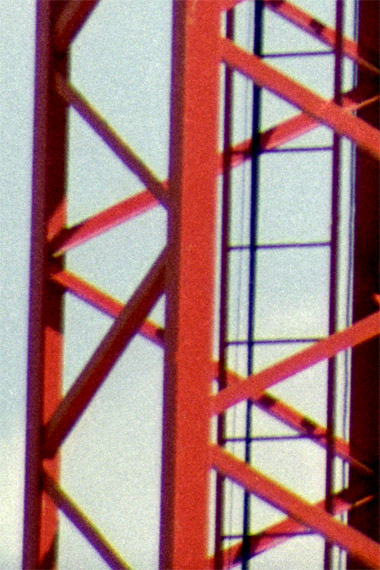
[C426-1_2cf1] 500mm Pentacon at f/5.6, 1/500 |
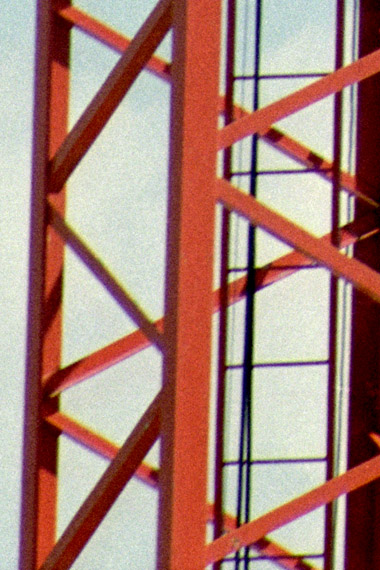
500mm Pentacon at f/11 1/125 |
At the massive degree of enlargement described on the previous page,
it is possible to observe a tiny amount of chromatic aberration (colour
fringeing). Note the hint of yellow/green to the right of boundaries
between different components of the picture, and the blue/purple shadow
to the left of them (i.e., yellow/green on the side nearer the middle of
the image and blue/purple on the side nearer the edge of the image).
This crop is taken from the bottom of the image. Stopping down any lens does not seem to affect the degree of colour fringeing directly, although if components of the image are sharpened up, it may be slightly more visible. At all normal degrees of enlargement and viewing distances, it is likely to be invisible anyway. Remember that both of these frames were focussed on the pale green (almost grey) crane, which is quite a distance behind the red crane. However, there is very little difference in colour between that crane and the sky behind it, and actually no chromatic abberations are visible. I have preferred to show you the worst part of the image as regards chromatic aberrations, even though this part of the image was not completely in focus on many of the images in this test. |
Arsat APO f/5.6 500mm
This lens has a rotatable locking collar, with the locking wheel in approximately the same position as on the Pentacon lens, so the hand naturally goes to the right place without one having to look.
Coverage
At maximum aperture, there is very slight vignetting, which is particularly
noticeable in the top corners, especially the top left. This was
definitely not caused by the lens shade, which was most of the way back
on this shot. I must say that this is in no way comparable with the
vignetting observed with the two Rubinars, and after looking at those pictures,
I hardly notice the slight reduction in brightness in the extreme corners
of the pictures taken with this lens.
At f/11 (incidentally with the lens shade now fully forward) this vignetting had virtually disappeared, though if you were looking for it, you might see something in the extreme top-left corner. These shots were taken into a blue sky, a particularly testing target for vignetting. In most pictures, it would not be noticeable, at least at f/11.
Arsat APO 500mm
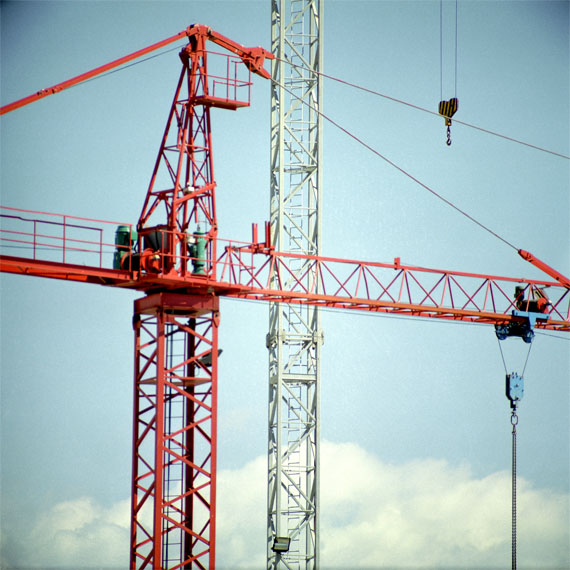
[C426-4] at f/5.6, shade most way back 1/500 |

[C426-6] at f/11, shade fully forward 1/125 |
Resolution
This lens gives good, sharp images with very high resolution, even
at full aperture. Again, the point of critical focus in these two
images is clearly on the rear crane. Naturally, when the lens is
stopped down, there is a significant increase in depth of field that in
these pictures brings the front crane into sharper focus.
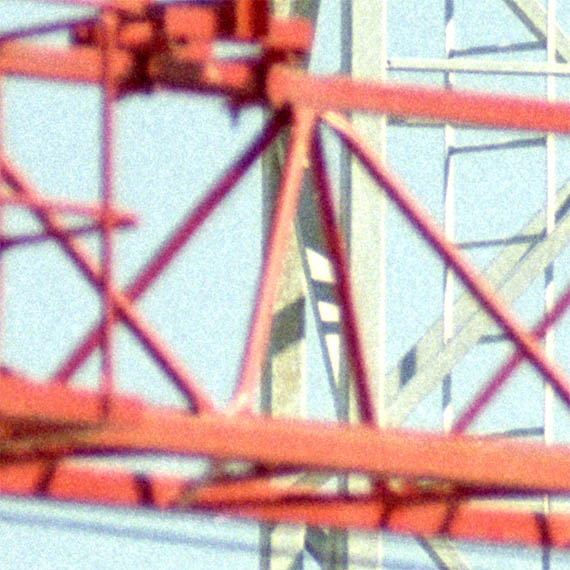
[C426-4r] at f/5.6, 1/500 |
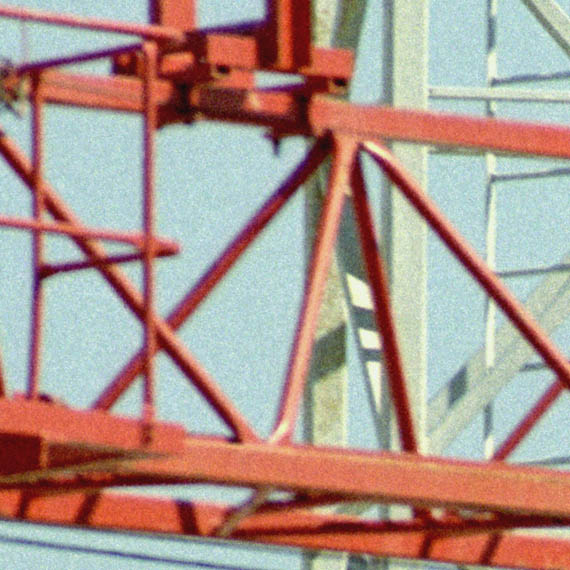
[C426-6r] at f/11 1/125 |
Colour fringeing
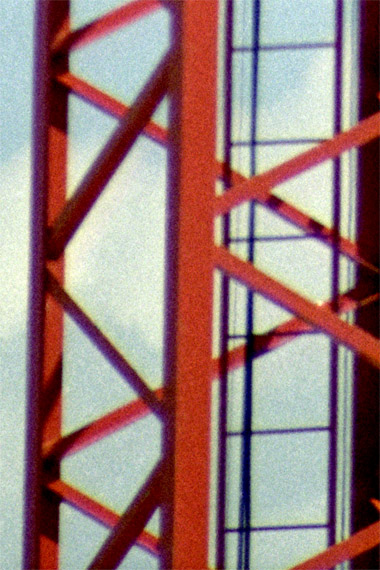
[C426-4cf1] 500mm APO at f/5.6, 1/500 |
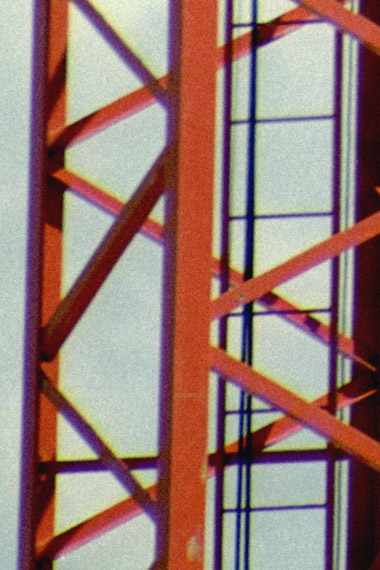
500mm APO at f/11, 1/125 |
Where a dark object is in front of a light background, at the enormous magnification shown here – on my screen equivalent to 2.877 × 2.877 m (approximately 9' 5½" × 9' 5½") – , very slight colour fringeing can be seen. This consists of an extremely faint yellow shadow on the side of the dark object nearer the centre of the image and a slightly more pronounced blue/purple shadow on the other side of it. Stopping down the lens aperture appears to have no effect on colour fringeing. |
Rubinar f/5.6 500mm mirror lens
This lens is in fact very similar in size to the 3M – 3B 600mm mirror lens from Arsenal. This was a disappointment to me when the lens arrived, as I had hoped for something smaller than the Arsenal mirror lens.
Any 500mm lens will have a shallow depth of field, especially at large apertures, and f/5.6 is a large aperture for such a focal length. Examination of the print – and of the scanned negative on my large computer screen – reveals that only the red crane is in focus. The other crane behind it is quite blurred. As best as I am able to calculate, having observed the cranes from other angles, the pale green crane (almost light grey) is 25 – 30 metres behind the red one, viewed from the position from where I took the pictures. In fact, when studying this image from close up at extremely large magnification, it is clear that no part of the original test image (shown on the right below) is completely sharp. There can be two causes for this.
Coverage
With this lens there is considerable vignetting in the corners, particularly
noticeable at the top of the frame, and this extends quite a way into the
image. It could be corrected – or at least substantially reduced
– with imaging software, but we want to see what these lenses achieve without
needing tweaking on a computer!
“500”mm f/5.6 Rubinar
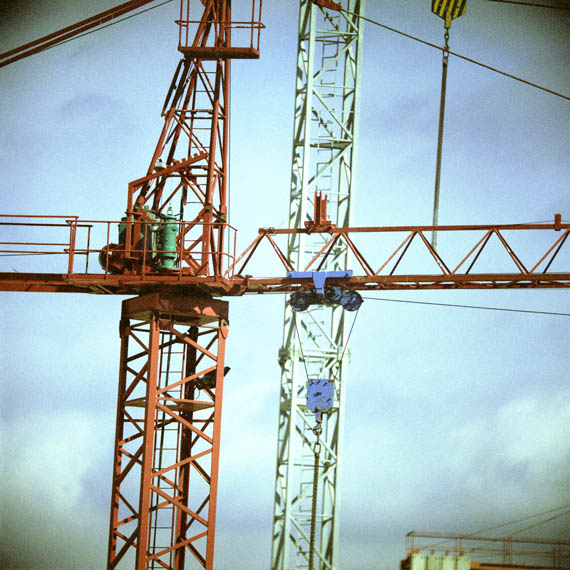
[C437-11/12] 1/1000 Fuji NPH 400 |
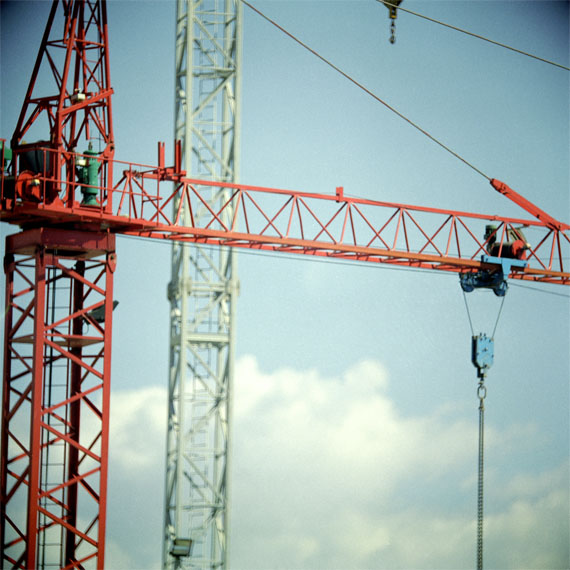
Fuji NPC 160 |
I repeat that this is not caused by a lens shade nor by a filter for either of these shots, and as mirror lenses can’t be stopped down, there is no way to correct this in camera. For non-critical situations, where there is not a clear blue sky across the top of the frame, you might get away with the vignetting unnoticed or not particularly obvious, but quite frankly, this lens does not adequately cover the 6 × 6 format.
Incidentally, it is immediately obvious that this lens magnifies the image more than the two above 500mm lenses. It is for this reason that I have put “500” in inverted commas. This is more like a 600mm lens – see below.
Resolution
In spite of the larger grain of the 400 ISO film, the resolution is
clearly good in the centre of the image. With any lens, when
the grain is more obvious than any lack of resolution, then the lens must
be good. Unfortunately, the vignetting near the corners reduces
the contrast in those parts of the image, as will in passing be observed
in the “colour fringeing” image below. The extremely shallow depth of field
at f/5.6 makes focussing difficult. However, it is significant that
the image taken with the Pentacon 500mm lens at its full aperture
of f/5.6 is sharp. Here, the focus is not quite on the red
crane, with the light green crane behind it well out of focus.
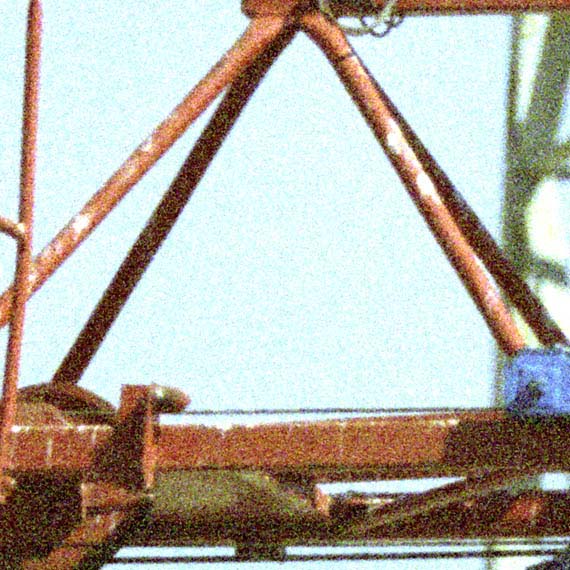
[C437-11/12r]
“500”mm f/5.6 Rubinar 1/1000
Fuji NPH 400
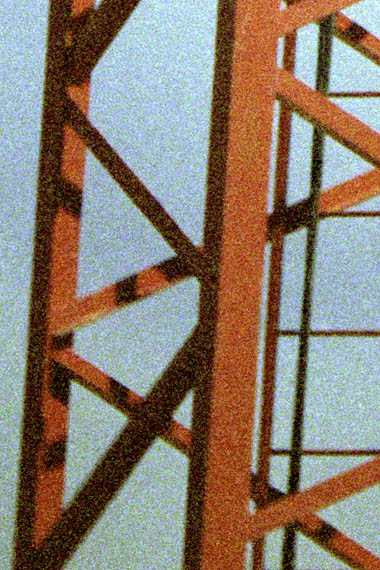
[C437-11/12cf1] 500mm f/5.6 Rubinar 1/500 Fuji NPH 400 |
As is to be expected from a mirror lens, virtually no colour fringeing is visible, even at an enormous degree of magnification. Note that this section is talen from bottom edge of image, where the vignetting results in a deterioration of contrast and therefore of resolution |
Rubinar f/8 500mm mirror lens
This is a small, compact, lightweight lens. If it can deliver good results, it will be a great lens to have. The increase in depth of field at f/8 is clearly obvious, compared with the f/5.6 Rubinar. (Look at the distant crane in the bottom-right corner of the two Fuji NPH 400 shots.) At a massive degree of enlargement, it is possible to see that the point of critical focus in the original test (shown in the image on the right) is on the rear crane, but for normal degrees of enlargement both cranes are acceptably sharp. Of course, with 1 stop less light coming into the camera, I had to use a slower shutter speed (1/250) in the original test, and this did not cause any problems due to camera or object movement.
I subsequently re-shot this test, using Fuji NPH 400 film. This enabled me to use a faster shutter speed (1/500). The resultant image is shown on the left, below, and is also used for the Resolution and Colour Fringeing enlargements.
Coverage
However, the coverage is only a little better than with the other Rubinar.
There is slightly less vignetting, but it’s not particularly obvious that
this is the case. Again, no lens hood (shade) nor filter was attached
to the lens for this set of tests.
“500”mm f/8 Rubinar
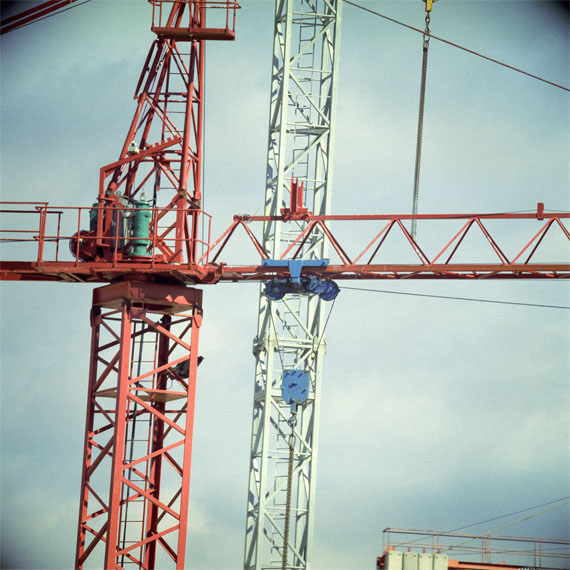
[C437-10] 1/500 Fuji NPH 400 |
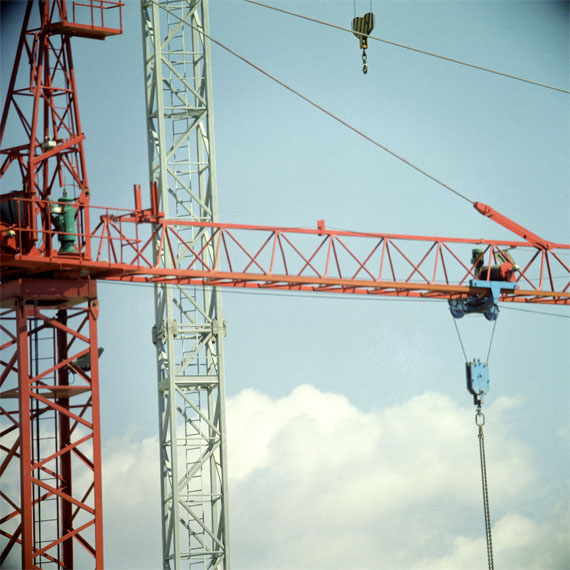
Fuji NPC 160 |
The degree of magnification seems to be virtually identical to the other Rubinar lens. In other words, this “500”mm lens is more equivalent to 600mm – which may of course be what many users will prefer.
Resolution
Resolution is good with this lens. Focus is on the rear crane.
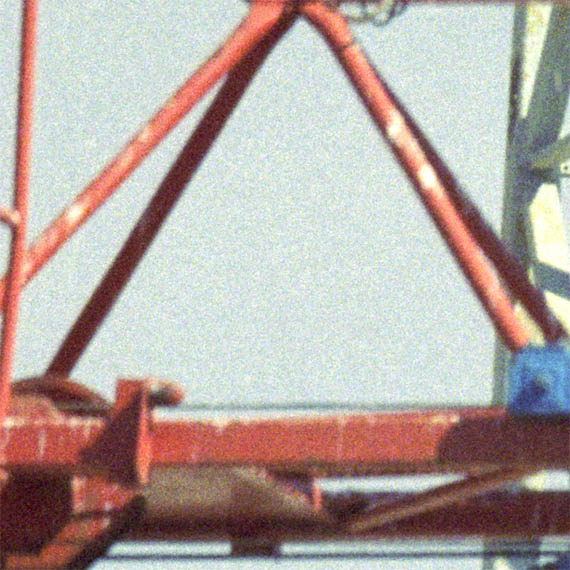
[C437-10r]
“500”mm f/8 Rubinar 1/500
Fuji NPH 400
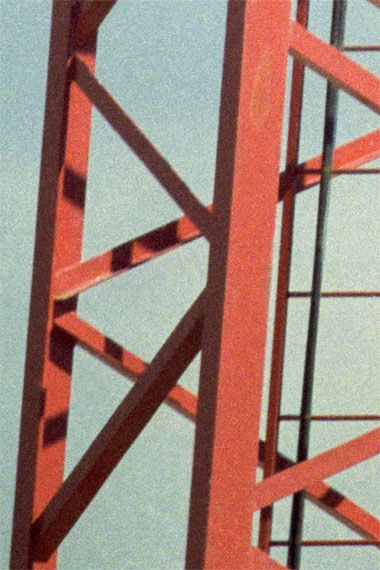
[C437-10cf1] 500mm f/8 Rubinar 1/250 |
Even at enormous magnification, colour fringeing is not detectable with images taken with this lens. |
Arsat 3M – 3B f/8 600mm mirror lens
For these tests, the Hasselblad Professional compendium lens shade 93 (no. 40726) as described here was mounted on the lens.
Like the Pentacon and Arsat 500mm lenses, this lens has a rotating lockable collar, which is very useful in helping to align the image correctly.
Coverage
Coverage is absolutely even across the whole of the frame, right into
the corners. This is an excellent result.
3M – 3B f/8 600mm mirror lens
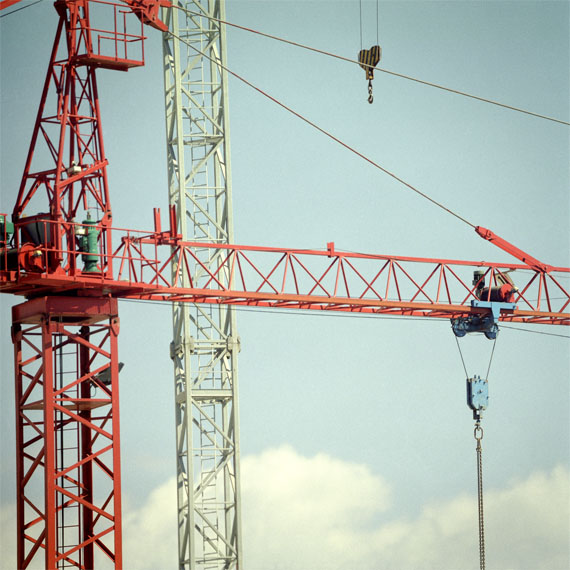
[C426-7] with Hasselblad compendium shade fully extended 1/250
Resolution
Again, critical focus was clearly on the rear crane. The resolution
obtained with this lens – at the point focussed on! – is superb.
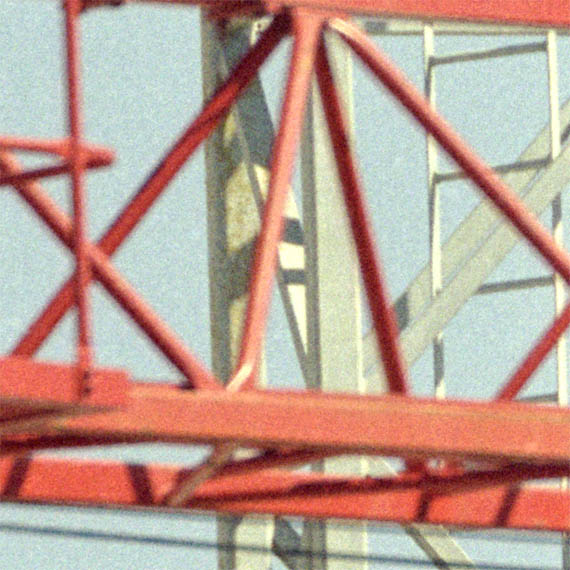
[C426-7r]
3M – 3B f/8 600mm mirror lens
1/250
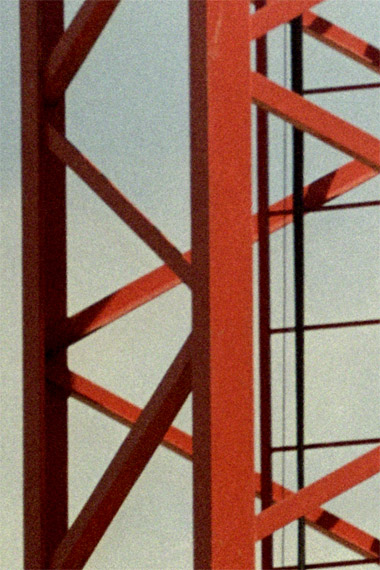
[C426-7cf1] 3M – 3B f/8 600mm mirror lens 1/250 |
There is a total absence of any colour fringeing with this lens. Considering that the point of critical focus was the rear crane, which is not visible in this section of the image, the results are indeed superb. |
Arsenal Telear/Arsat f/5.6 250mm lens with Arsenal 2× converter
This lens was tested at f/5.6 and f/11, which with a 2× converter attached resulted in effective apertures of f/11 and f/22 respectively
Coverage
At f/5.6, this combination results in minor vignetting similar to the
result produced by the Arsat APO 500mm lens at f/5.6, but unfortunately
at f/11 there is no improvement. In fact, I almost think that the
top corners are darker. Since coverage with this lens on its own
is faultless even at maximum aperture (see here),
the slight vignetting must be down to the converter, about which I comment
in greater detail in the 1000mm section. There is a large fingerprint
in the top-right-hand corner of the full aperture negative – placed there
by the staff of the processing lab! I could have cloned it out, but
that would have falsified the representation of the vignetting in the corner,
so I have left it intact. I have of course written to the processing
lab about the sloppy work that led to many of the negatives arriving with
fingerprints on them.
250mm f/5.6 Telear/Arsat with Arsenal 2× converter
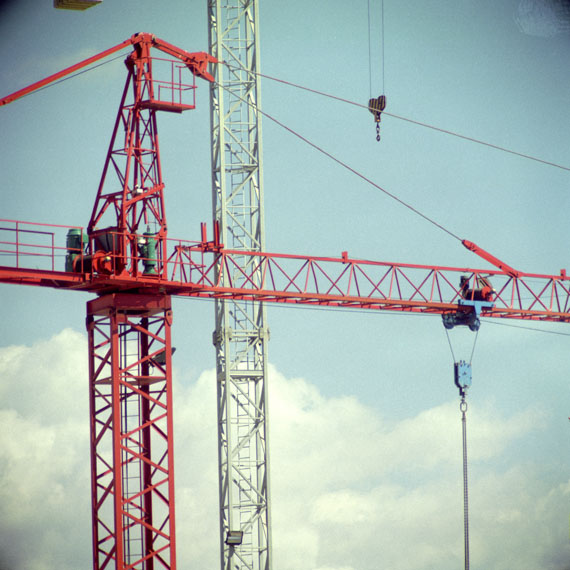
[C426-12] at f/5.6 (effective f/11) 1/125 |
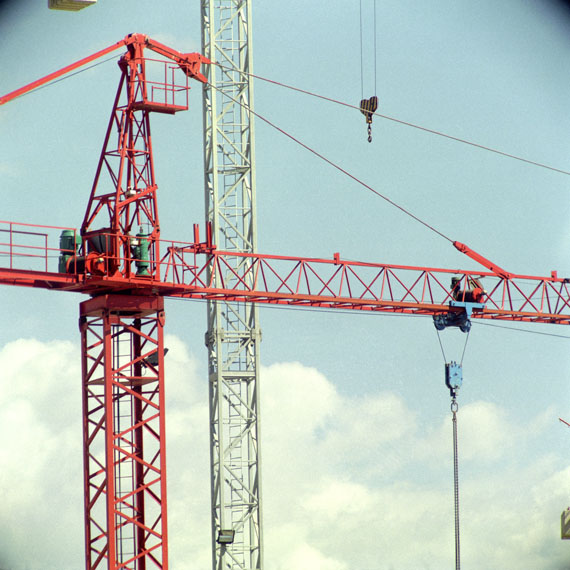
[C426-13] at f/11 (effective f/22) 1/60 (under-exposed by 1 stop) |
The f/11 (effective f/22) shot was repeated [C427-13] with a different shutter speed (1/250) after a change in the light, with identical results as regards coverage.
Resolution
This combination produces a very sharp image, even at maximum aperture.
With the prime lens closed down to f/11 (effective f/22 as far as light
intensity), the depth of field is considerable, and both cranes are sharply
in focus. However, even stopped down, this lens + the Arsenal 2×
converter is no match for the 3M – 3B f/8 600mm mirror lens.
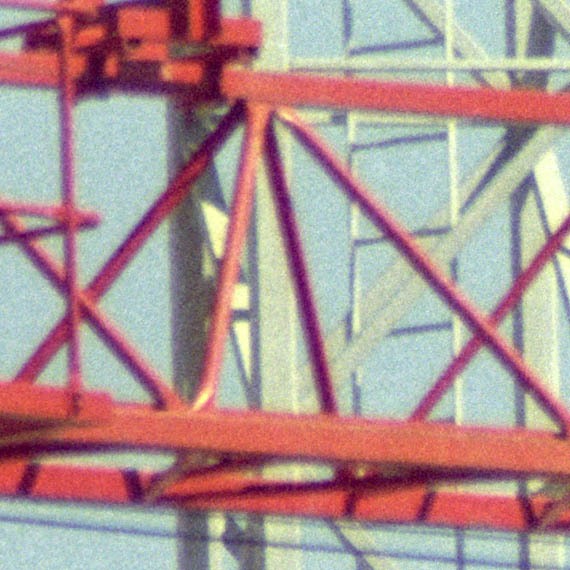
[C426-12r] at f/5.6 (effective f/11) 1/125 |
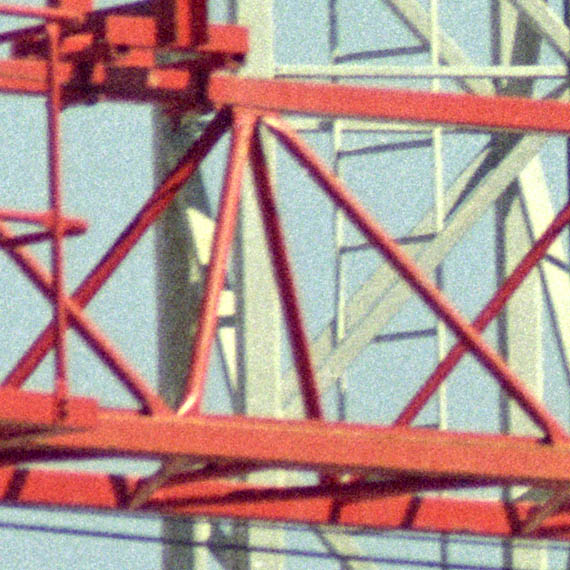
[C426-13r] at f/11 (effective f/22) 1/60 (under-exposed by 1 stop) |
Colour fringeing
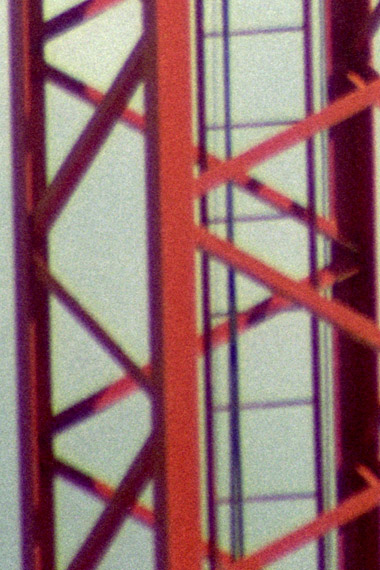
[C426-12cf1] at f/5.6 (effective f/11) /125 |
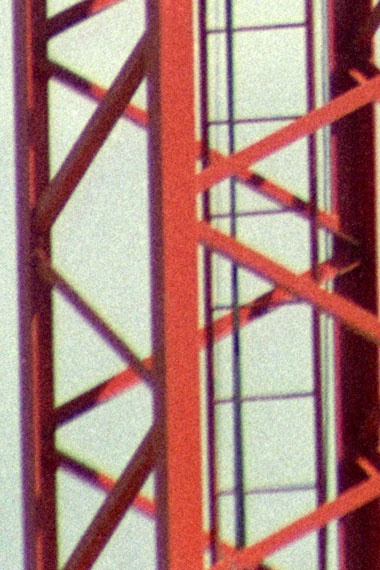
[C426-13cf1] at f/11 (effective f/22) 1/60 |
At extreme levels of magnification, considerable colour fringeing is visible – more, it seems to me, than with the 500mm Pentacon or Arsat APO. Of course, this could simply be because the 2× converter is doubling the size any lens aberrations at the same time as it doubles the effective focal length of the lens. However, at normal print sizes and viewing distances, this chromatic aberration is not noticeable. |
Arsenal Jupiter f/3.5 250mm lens with Arsenal 2× converter
This was tested at its maximum aperture of f/3.5, as well as at f/5.6 and f/11, resulting in effective apertures through the 2× converter of f/6.3, f/11 and f/22, respectively.
Coverage
At f/3.5, coverage is good, although if you look, you will see some
slight darkening in the corners.
At f/5.6, the results are virtually identical to at maximum aperture
(although stopping down has of course increased depth of field).
At f/11 darkening of the corners is worse: it does not extend any further
into the image overall, but it is much more marked (i.e., darker) in the
very corners.
250mm f/3.5 Jupiter with Arsenal 2× converter
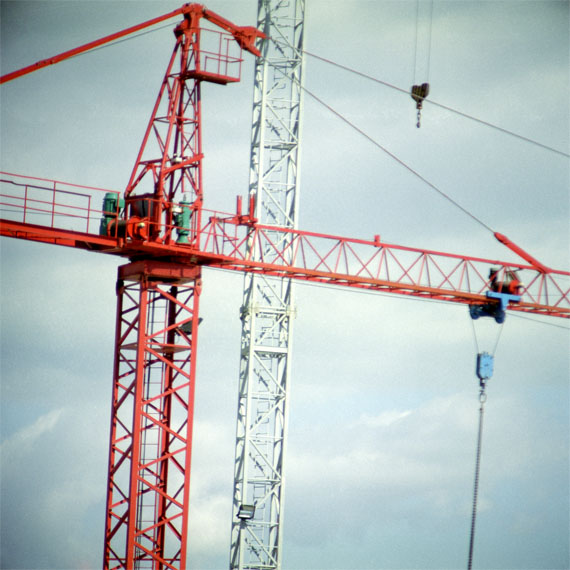
[C427-16] at f/3.5 (effective f/7) 1/500 |
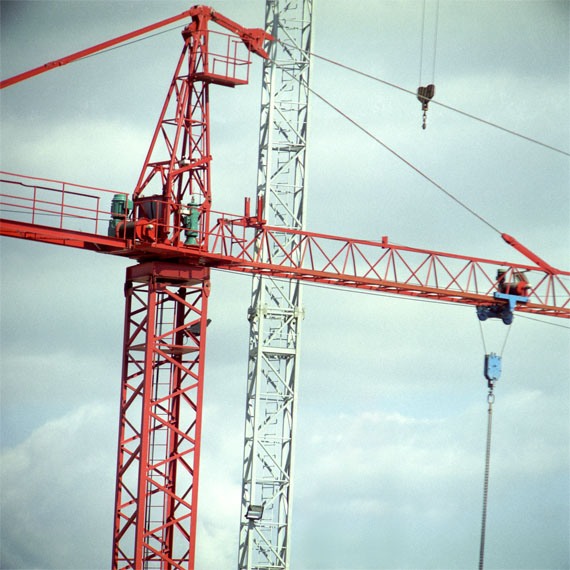
[C427-17] at f/5.6 (effective f/11) 1/125 |
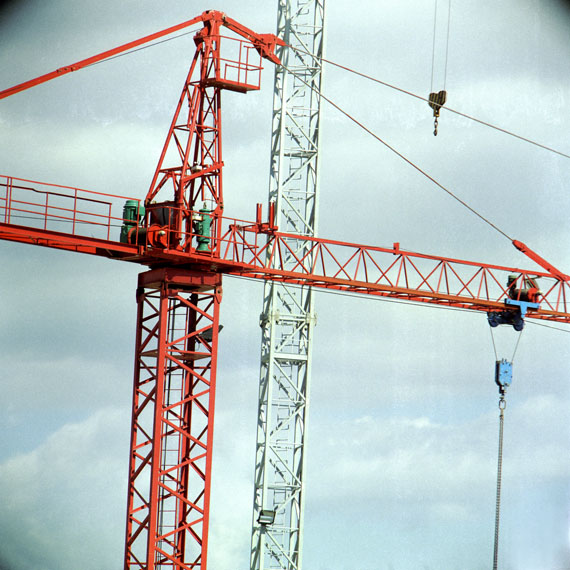
[C427-19] at f/11 (effective f/22) 1/125 (sic) |
Resolution
As is to be expected, at its large maximum aperture of f/3.5, this
lens does not deliver the same resolution as the Telear/Arsat f/5.6 250mm
lens + the same converter, and there is a considerable fall-off in quality
away from the centre. As I wrote after completing the original test
of this lens (see here), “at its maximum
aperture of f/3.5, the Jupiter is SOFT across the whole of the frame.
Use this aperture to help you focus, NOT to take pictures.”
Even stopped down to f/5.6, this lens with the converter is no match
for the 500mm Pentacon, and this is clear even in a 9" (approx 23 cm) square
print. However, it does of course yield a sharper image than at full
aperture, and also the depth of field is increased to a point where it
covers both cranes – thus also increasing the sharpness of the further-away
crane.
At f/11 the image sharpens up considerably again, and image resolution
is more than satisfactory at normal degrees of enlargement. This
really is a good result, as far as resolution is concerned.
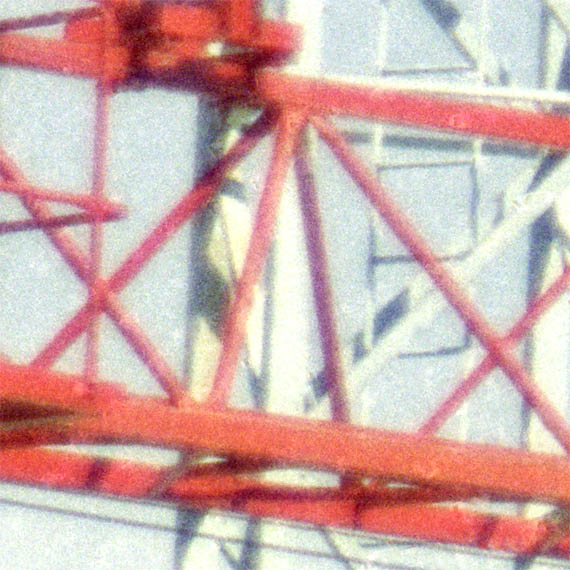
[C427-16r] at f/3.5 (effective f/7) 1/500 Some problems with this image have been caused by fingerprints from the staff at the processing laboratory! (seen at this magnification as a mottled effect) |

[C427-17r] at f/5.6 (effective f/11) 1/125 |
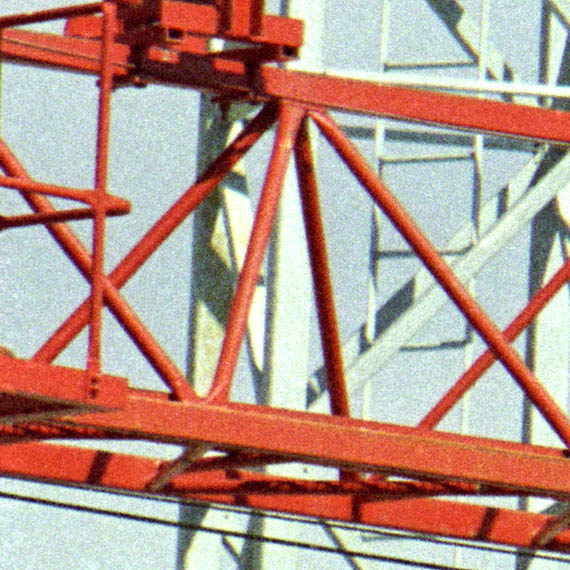
[C427-19r] at f/11 (effective f/22) 1/125 (sic) |
Colour fringeing
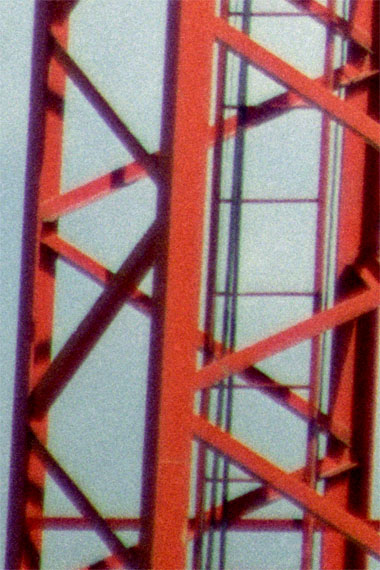
[C427-16cf1] at f/3.5 (effective f/7) 1/500 |
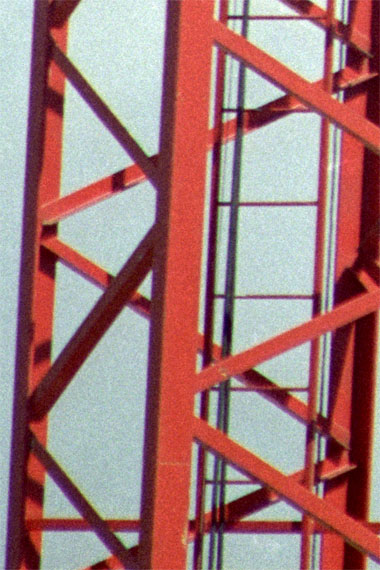
[C427-17cf1] at f/5.6 (effective f/11) 1/125 |
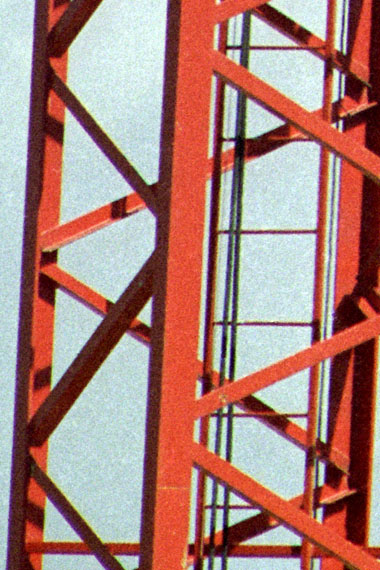
[C427-19cf1] at f/11 (effective f/22) 1/125 (sic) |
There is significantly less colour fringeing with this lens than with the Telear/Arsat f/5.6 250mm lens + the same converter. |
Joseph Schneider-Kreuznach Tele-Xenar f/5.6 250mm lens with Schneider 2× converter
Like the f/5.6 Telear/Arsat, this lens was tested at f/5.6 and f/11, which with a 2× converter attached resulted in effective apertures of f/11 and f/22 respectively
Coverage
Of the three 250mm + 2× combinations tested here, the Schneider
Tele-Xenar with Schneider converter comes out clearly on top, with a minuscule
amount of corner darkening at maximum aperture that is virtually impossible
to see (judge for yourself from the images below) – definitely well within
tolerances for the best quality lenses at this focal length. The
500mm Pentacon at maximum aperture is fractionally better, being virtually
faultless in this regard, but the difference is tiny.
At f/11, the Tele-Xenar + 2× converter has absolutely impeccable coverage right into the corners.
250mm f/5.6 Schneider-Kreuznach Tele-Xenar with Schneider Exakta 66 2× converter
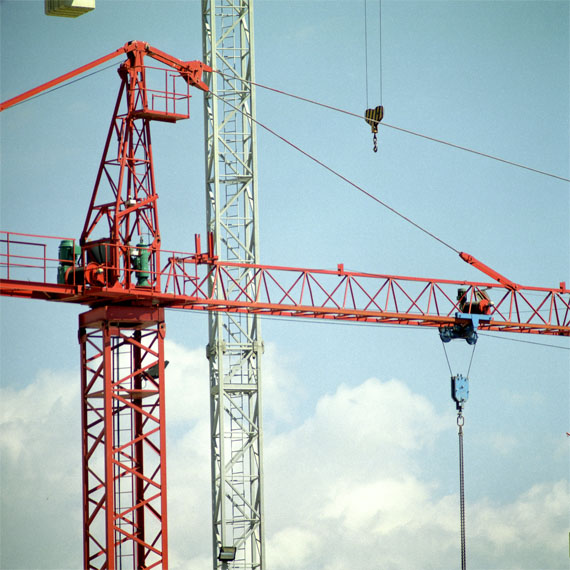
[C426-14_15] at f/5.6 (effective f/11) 1/125 |
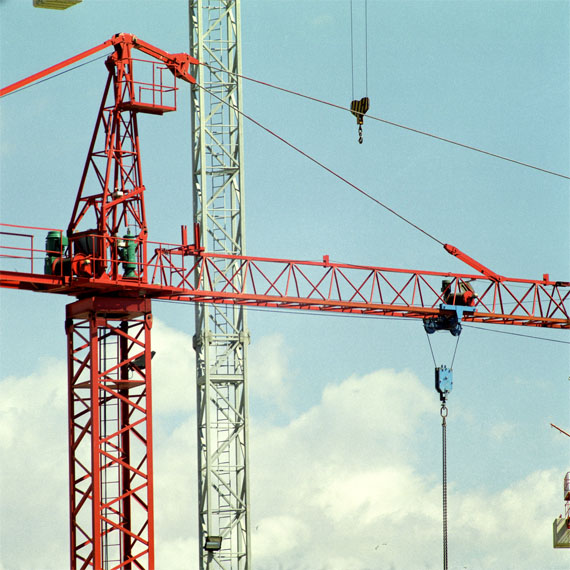
[C426-16] at f/11 (effective f/22) 1/60 (under-exposed 1 stop) |
The f/11 (effective f/22) shot was repeated [C427-14] after a change in the light at a different shutter speed (1/250), with identical results as regards coverage.
Resolution
Resolution is outstanding. This lens definitely deserves
the high reputation that it has, and performance with the 2× converter
that Schneider designed to work with it is outstanding. With massive
enlargements, it is clear that this lens is enormously better than
the Arsenal Jupiter, which I described above as “really ... good” at f/11.
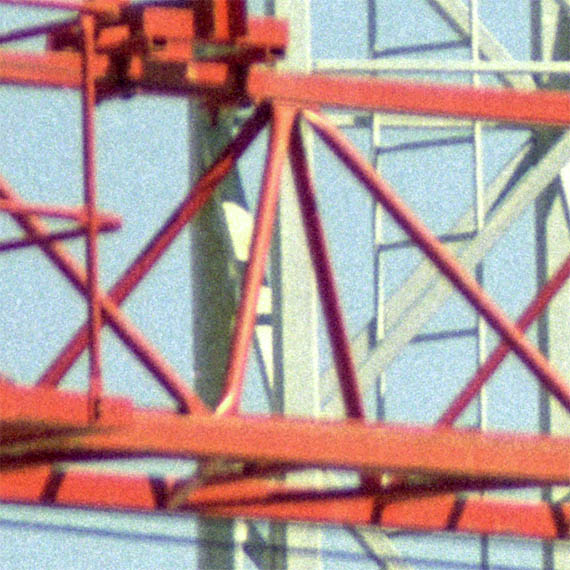
[C426-14_15r] at f/5.6 (effective f/11) 1/125 |
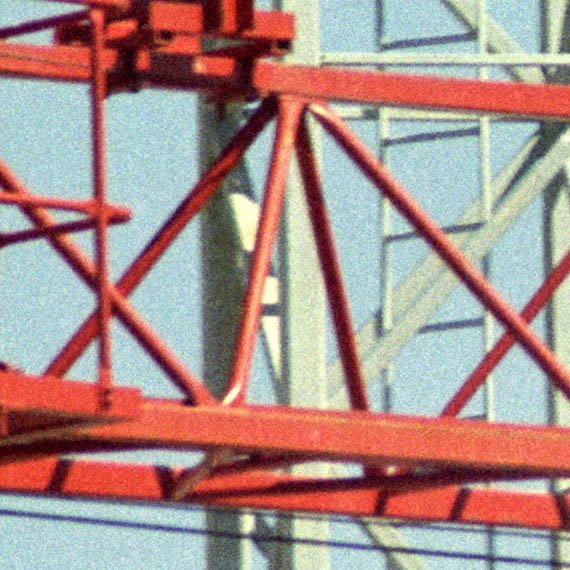
[C426-16r] at f/11 (effective f/22) 1/60 (under-exposed 1 stop) |
Colour fringeing
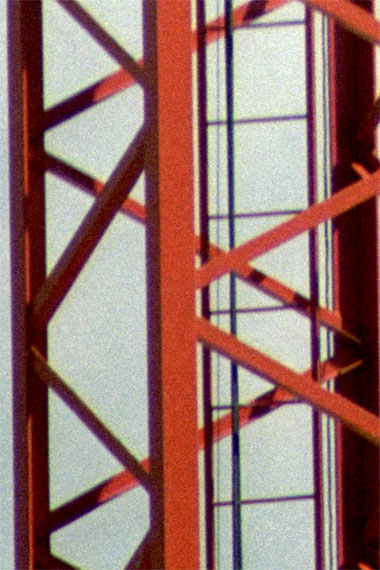
[C426-14_15cf1] at f/5.6 (effective f/11) 1/125 |
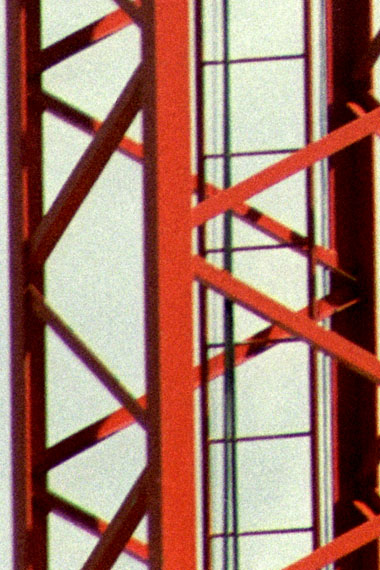
[C426-16cf1] at f/11 (effective f/22) /60 |
At the massive degree of enlargement described on the previous page, and viewed from abnormally close up, a tiny amount of colour fringeing is detectable. However, at normal viewing distances this just cannot be seen. As regards chromatic aberrations, or colour fringeing, this is the best result from any of the lenses tested here except the mirror lenses. |
Conclusion
Judged by coverage alone, of the 500 – 600mm lenses, the 500mm Pentacon and the 600mm 3M – 3B come out top, closely followed by the 500mm Arsat APO lens, with the two Rubinars trailing a long way behind.
If we include the 250mm lenses used with a 2× converter, the Schneider-Kreuznach combination is the obvious clear winner, with the two Arsenal lenses (the f/3.5 Jupiter and the f/5.6 Telear) trailing some way behind, with very little to choose between them. However, I suspect that the vignetting problem is caused by the teleconverter – see the new 1000mm write-up, now available.
Judged by image resolution, two lenses probably tie as “joint best”: the 600mm Arsenal 3M – 3B, and the Schneider-Kreuznach 250mm Tele-Xenar with the Schneider 2× converter, but two other lenses are close behind them: the 500mm Pentacon and the 500mm Arsenal APO. At normal degrees of enlargement and normal viewing distances, it is generally impossible to distinguish between the resolution of these four lenses.
Looking at colour fringeing (or the lack of it), mirror lenses are best, which in this test means the 3M – 3B (given the severe vignetting with the other two mirror lenses). An extremely close second is the Schneider Tele-Xenar with their 2× converter. In joint third place come the two 500mm lenses, the Pentacon and the Arsenal APO, about neck and neck, with the two 250mm Arsenal lenses (the Telear and the Jupiter) trailing behind them.
All lens designs are the result of a compromise: a balance between performance, size, weight and cost. In many cases, the absolutely peak performance would result in a lens that was too heavy to carry or too expensive for most people to buy. Going for this option might be right for a scientific observatory, but not for ordinary photographers – or even most professionals. If you get the ultimate lens, but it is so heavy that you rarely take it with you, it won’t be there for that rare and special shot.
When all the factors are taken into account, my conclusion is that with the Arsat 500mm APO lens ends at last the long pilgrimage to find a lens of this focal length that can easily be carried and used. I can take this lens in my hand baggage on a plane, without it attracting attention or leading to problems with the airport security people. Unlike the Pentacon lens, it does not look like a bazooka! If only it had been produced ten – or more! – years earlier, it would have completely eclipsed the Pentacon lens – always assuming, of course, that it had been made available at an affordable price, which has unfortunately never been the case.
I obtained my 500mm Arsat APO lens from Zhanna in Kiev, who trades on eBay as “grizzly33bear”. I recommend her unreservedly as an outstanding, organised and trustworthy vendor. She rarely has this lens, but routinely offers the reasonably rare 600mm Arsenal 3M – 3B mirror lens at a much lower price than I paid for mine! Results from that lens, too, were excellent.
If you think that my conclusion is too generous, might I suggest that most of us have never seen our favourite lenses subjected to such rigorous tests as those carried out here. If they were, we might be surprised or disappointed to discover that – in an extreme test situation – they did not perform as well as we had expected. Yet for years these same lenses may have delivered pictures with which we were totally satisfied, from a technical point of view, and that, ultimately, is what counts.
To go on to the next section, click below.
1000mm tests
To go back to the beginning of the lens tests, click below and then
choose the focal length that you want to read about.
Back to beginning of lens tests
© TRA May 2007, November 2008